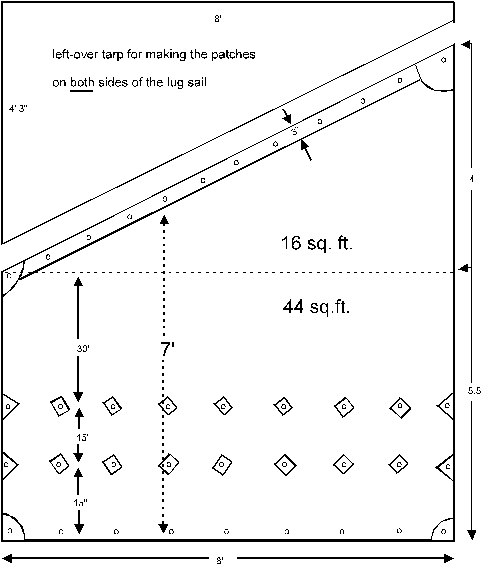| CHAPTER 4
RIGGING
Sail
The safe sail area for a 9-ft. Pram is 60
sq. ft. maximal.
The boat is rigged with a standing lugsail.
The dimensions are shown in the drawing below.

Only one side of the sail, the head requires a
modification of the tarp.
The new seam is 3"
wide". It is done with
double side sticking tape, or by gluing the seam with a clothes iron
that is turned up to approximately three quarters of its maximum
setting. This is the neatest, and the most solid way if you can get
the “knack” for it.
Place a piece of ¼"
rope in the seam with a half knot at each end on the outside of the
sail. Seal the ends of the
nylon rope with a hot soldering iron.
The seam is further
reinforced with 10 grommets with a ⅜" dia. hole, and a
grommets with ½" dia. hole at each corner.
Before these two grommets are inserted into the corners,
reinforce these two corners with patches as shown in the drawing on page
28.
After the head is cut, a right triangle of material is left over.
The short leg of this triangle is 4.3".
From this material, for both sides, cut the reinforcement
patches and glue them onto the four corners.
The four smaller, triangular patches go onto the luff and the
leech. The fourteen square
patches are for the reef points. These
patches measure only 2"x2".
Altogether, 39 grommets are used in the sail.
Parrels
The top yard and the boom are kept against the mast
by parrels. A loop
on one side of each spar is a simple solution.
It does not interfere with the spar adjustments when tuning the
sail for (slight) weather helm. The
¼" lines for the parrels are 3' long.
Top Yard
The head of the sail is laced onto one of the two 10'
- 1½" dia. wood poles. Drill
a ⅜" hole in each end of the yard for the lace line,
and to keep the line taut. The
⅜" holes for the loop of the parrel line in the top
yard are placed 24" apart.
The first hole is 30" aft of the spar end fore.
Boom
The foot of the sail is laced to the boom through
the two grommets with a ½" hole at the corners and seven
grommets with a ⅜" hole in between.
The ⅜" holes for the parrel loop are 24"
apart. The first hole is 18"
aft of the in/outhaul U-link. See
the drawing below.

1.
Make up the boom by gluing the ½" side of the last ⅝"x½"
slat upon the narrow (¾") side of the 8' - ¾"x
1.3" batten shown on page 11. The ⅜" holes in this slat are lined up with
the grommets in the foot of the sail.
2.
Round the edges of the boom.
3.
Attach a stainless steel block hanger at ⅓ of the
boom length aft. The head
of the single sheave block with head and becket is hung at this hanger.
The mainsheet is attached to the becket of the block.
4.
Drill a ⅜" hole fore at the boom.
Attach a stainless steel U-link at the hole.
The in/outhaul line is knotted to this U-link
Mast
The length of the sail at 2.5' aft of the
luff is 7'.
The length of the 10' - 1½" dia. mast
above the mast thwart is 8' 9¾".
With an extra 2" deducted for the fairlead at the top
of the mast to hoist the sail, it gives enough room to attach the
halyard at this point to the top yard for the first sail trial to find
the correct point where the halyard should be tied for a slight weather
helm.
Halyard,
Halyard Belaying Spoke
Make the halyard 20'. Drill a ⅝" hole in the mast thwart about 2"
beside the mast and 1" fore of the rear edge of the
bench. Round the edges of a
12" - 1x1 until it will fit into the hole in the bench.
Glue it in the hole with equal ends protruding above and below
the thwart. Belay the
halyard onto the spoke.
In/Outhaul
With the in/outhaul the sail is fine-tuned
for a (slight) weather helm.
The line is 18' long.
1.
Mount a fairlead with a ½" hole on the centerline of
the bow deck 4" aft of the bow board.
2.
From the middle thwart plus an extra 12", lead the
in/outhaul line to the U-link fore at the boom.
This is the inhaul part of the line.
Attach it with a knot to the U-link.
3.
From the U-link, pull the line through the fairlead and lead it
back to the middle thwart with another extra 12" to spare.
This is the outhaul part of the line.
4.
Make three or four knots in both ends of the line 2"
apart.
5.
Make a 2" deep-V notch in the middle thwart.
Belay the end of the haul that is pulled taut into the deep-V
notch. The knots will hold
the boom in position.
Painter
|
![]()